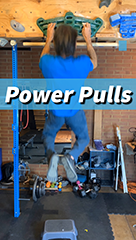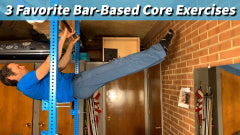Toes to Knows Climbing Academy

Academy: Strength Assessment
Climbing is a skill sport, but strength also plays a huge role in climbing success. As you progress up the grades in climbing, strength grows in importance. In this video,...
Academy: Strength Assessment
Climbing is a skill sport, but strength also plays a huge role in climbing success. As you progress up the grades in climbing, strength grows in importance. In this video,...

Academy: Power Pulls
Power is force applied quickly and it’s an important skill for hard rock climbing. The campus board is the classic way that climbers train power, but it’s not the right...
Academy: Power Pulls
Power is force applied quickly and it’s an important skill for hard rock climbing. The campus board is the classic way that climbers train power, but it’s not the right...

Academy: 3 Favorite Bar-Based Core Exercises
Shoulder strength integrated with core strength is helpful for climbers, especially if you like to climb steep routes. My three favorite bar-based core exercises to help build that integrated shoulder...
Academy: 3 Favorite Bar-Based Core Exercises
Shoulder strength integrated with core strength is helpful for climbers, especially if you like to climb steep routes. My three favorite bar-based core exercises to help build that integrated shoulder...

Academy: Power Pushup
Climbers need both strength and power. Power is just strength applied quickly. A power pushup is a great way to build power in your antagonistic pushing muscles. No extra weights...
Academy: Power Pushup
Climbers need both strength and power. Power is just strength applied quickly. A power pushup is a great way to build power in your antagonistic pushing muscles. No extra weights...

Academy: Isometric Planks
In the Lyti training summer series, Lyti struggles with doing regular pushups, making it hard to progress the exercise for her. One alternative exercise that works pretty well is an...
Academy: Isometric Planks
In the Lyti training summer series, Lyti struggles with doing regular pushups, making it hard to progress the exercise for her. One alternative exercise that works pretty well is an...

Academy: Lyti's Training Plan
Part of our "Toes to Knows" Climbing Academy series--covering climbing from footwork to mental preparation. Tags: Coaching, Hangboarding, Advanced, Intermediate, Training In this post, we go over a training protocol...
Academy: Lyti's Training Plan
Part of our "Toes to Knows" Climbing Academy series--covering climbing from footwork to mental preparation. Tags: Coaching, Hangboarding, Advanced, Intermediate, Training In this post, we go over a training protocol...
